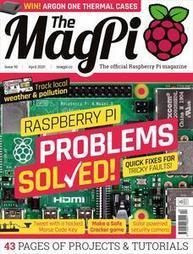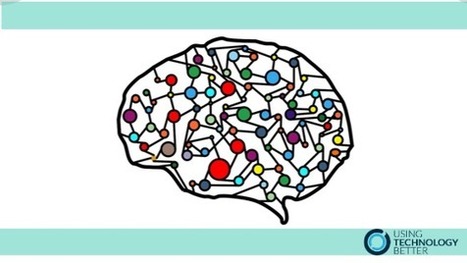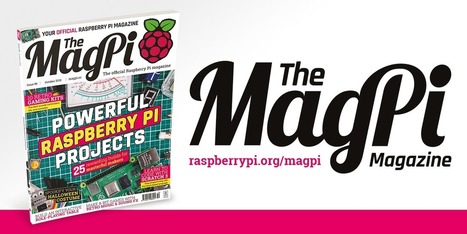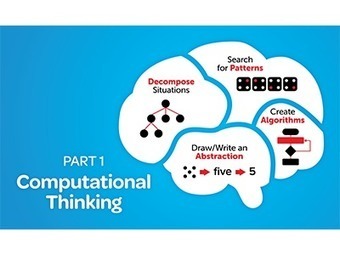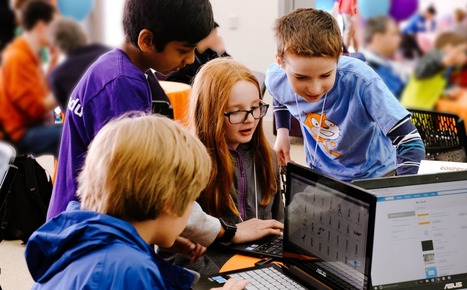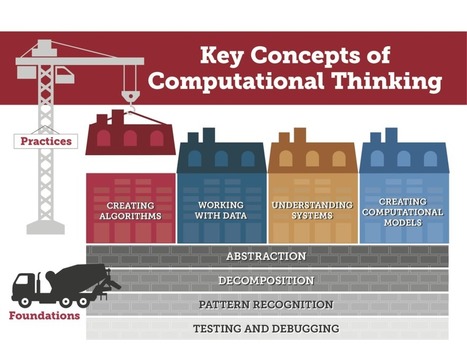 Your new post is loading...
 Your new post is loading...

|
Scooped by
John Evans
|
"Cybersecurity threats are increasing and changing all the time; teaching students how to protect themselves is vital. This issue spans the ethics and legalities of hacking, advice about teaching cybersecurity to primary-school children, and an introduction to quantum cryptography.
We also share some fantastic ideas for making this topic as hands-on as possible, including through using network robots, using tools and techniques used by real-life penetration testers, and by taking part in a ‘capture the flag’ competition.
Also in this issue:
- Using computational methods to analyse literature
- Developing computational thinking skills through Japanese logic puzzles
- Top tips for representing computing at school open days" Download Free PDF

|
Scooped by
John Evans
|
Inside The MagPi magazine #92
Solve Raspberry Pi problems. Learn to diagnose and fix issues with Raspberry Pi. Get rid of glitches and odd behaviour, sort out boot problems, reconnect networking problems, and discover advanced troubleshooting tips. - Track weather and pollution with Raspberry Pi. Set up a Raspberry Pi to measure air quality, humidity, UV monitoring, and make your own weather forecasts.
- Tweet with a hacked Morse code key. Learn Morse and send tweets using a simple switch!
- Add facial recognition to a magic mirror. Take your mirror to the next level with customised responses based on who gazes into it.
- Discover Instaclock. Building a clock with Raspberry Pi computers and four screens that take images from Instagram.
- Make a safe cracker game. Use continuously rotating control for Raspberry Pi to create a rotary encoder game.
- Solar powered security camera. Set up an eye in the sky using Raspberry Pi. This camera can be placed in the garden, and provides itself with power.
- Make bread with a sourdough incubator. Here’s a radical baker using his loaf. The Chamber Sourdough Incubator uses a Raspberry Pi to keep a starter at the correct temperature.
- Top 10 audio projects. Want to build something that sounds amazing? Here are ten amazing sound-based projects.
- Win! Argon One cooling cases.
FREE DIGITAL DOWNLOAD

|
Scooped by
John Evans
|
Ask many teachers what computational thinking is and they’ll look at you with a blank face. I used to feel like that! But actually, I’ve come to realise it’s not that complicated at all.

|
Scooped by
John Evans
|
Discover your next incredible build in the latest edition of The MagPi magazine
Plus! Spooktacular Halloween costume projects; the Stonehenge Skyscape; learn to code with Scratch 3; the best video game accessories; build a dashcam with Dride Zero for Raspberry Pi, and much more. Digital Download Available Here: https://www.raspberrypi.org/magpi-issues/MagPi86.pdf

|
Scooped by
John Evans
|
Presented by Sara Delano Moore, Ph.D., Director of Professional Learning
Computers and computer science are an ever-increasing part of our world. Computational thinking is foundational to these fields; it also supports mathematical process and practice standards. Computational thinking includes four core components: patterning, decomposition, algorithmic thinking, and abstraction. How do these ideas support grade-level mathematical concepts and skills? How do they develop the thinking skills required for careers in the STEM fields?
In this edWebinar, Sara Delano Moore, Ph.D., Director of Professional Learning at ORIGO Education, will provide an overview of computational thinking and explore the components of patterning and abstraction in more depth. She will introduce you to problems and learning experiences which develop this thinking with age-appropriate tasks. See how these unplugged tasks develop student thinking around mathematical structure and quantitative reasoning.

|
Scooped by
John Evans
|
This unit of six lessons introduces pupils to the history of computing and, in particular, how computers were used as code-cracking devices in World War II. Pupils learn about Alan Turing and become code crackers themselves. They then create their own movie about code cracking.

|
Scooped by
John Evans
|
As many teachers make the transition back into classes after the holidays, quite a few have plans to update lessons to include segments that introduce data science concepts. Why, you ask?
According to a LinkedIn report published last week, the most promising job in the US in 2019 is data scientist. And if you search for the top “hard skills” needed for 2019, data science is often in the top 10.
Data science, applied computation, predictive analytics… no matter what you call it, in a nutshell it’s gathering insight from data through analysis and knowing what questions to ask to get the right answers. As technology continues to advance, the career landscape also continues to evolve with a greater emphasis on data—so data science has quickly become an essential skill that’s popping up in all sorts of careers, including engineering, business, astronomy, athletics, marketing, economics, farming, meteorology, urban planning, sociology and nursing.
Digital escape rooms bring the excitement of hunting for clues and the joy of solving puzzles right to your student's devices. Here are over 30 digital escape rooms to try plus resources for creating them yourself!
Via Tom D'Amico (@TDOttawa)

|
Scooped by
John Evans
|
When we ask young people what motivates their participation on Scratch, they often emphasize the importance of their friends and other peers. Whether in person or online, peers motivate creative learning by sharing ideas, collaborating on projects, offering help, providing encouragement, and creating a sense of connection and community.
While there are numerous benefits to peer learning, I know from experience how challenging it can be to organize and facilitate a class or workshop so that all students have positive peer interactions and constructive collaborations. I have become fascinated to learn about the different ways that educators are supporting peer learning with Scratch.

|
Scooped by
John Evans
|
Computer science education is not a new field. Much of what we know about the pedagogy and content for elementary students comes from Seymour Papert’s research on teaching elementary students to code back in the 1970’s and 80’s. But, as we shift from labs and one-off classrooms to a broad expansion for all students in every classroom K-12, we are seeing changes to how computer science is taught. This means we are working in a rapidly evolving field (insert metaphor of building a plane while flying it). Over time, we have gone from a focus on coding (often in isolation) to a more broad idea of computer science as a whole, and now to the refined idea of computational thinking as a foundational understanding for all students.
Pause. You may be asking, “But wait, what’s computational thinking again?” In her book Coding as a Playground, Marina Umaschi Bers explained: “The notion of computational thinking encompasses a broad set of analytic and problem-solving skills, dispositions, habits, and approaches most often used in computer science, but that can serve everyone.” More simply, you can think of computational thinking as the thought processes involved in using algorithms to solve problems.
Across the United States and around the world, educators are being called on to help their students prepare for futures in an increasingly computational world. Integrating computational thinking into activities, lessons, and curricula not only supports building new skills, but also enhances learning and engagement in every discipline.
However, there are still many more educators who do not feel comfortable with computational thinking concepts than those who do.

|
Scooped by
John Evans
|
How one district makes computer science and computational thinking a priority for all students, regardless of background

|
Scooped by
John Evans
|
Machine learning is all around us. We all use machine learning systems every day - such as spam filters, recommendation engines, language translation services, chatbots and digital assistants, search engines, and fraud detection systems.
It will soon be normal for machine learning systems to drive our cars, and help doctors to diagnose and treat our illnesses.
It's important that kids are aware of how our world works. The best way to understand the capabilities and implications is to be able to build with this technology for themselves.
|

|
Scooped by
John Evans
|
While computer science (CS) and computational thinking (CT) have received increasing attention over the past decade, CT integration in early learning settings is an emerging area of focus. Our National Science Foundation (NSF)-funded project, a collaboration with SRI International, Edfinity, and Curious Media, aimed to identify CT skills aligned with the abilities and interests of preschool children (age 3-5 years). The project looked at how those skills could be integrated in common preschool and home STEM learning experiences in mutually supportive ways.

|
Scooped by
John Evans
|
CS is part of computing education and it’s the foundation for ALL computing. So, in essence, CS is the study of computers and the algorithmic design processes in both hardware and software — their application and overall impact on society.
On the other hand, CT is a problem-solving skill(s) that involves decomposition, abstraction, pattern recognition and algorithm design.

|
Scooped by
John Evans
|
Say you’re trying to solve a sudoku. You look at the various numbers that fill the squares and begin to work your way through the lines and boxes bit by bit, adding values and searching for any unused digits. If the puzzle is easy, you may be able to brute-force a solution. But what if the sudoku is a bit more challenging?
As you look at the puzzle, you may notice how numbers seem to be arranged just so. A number here, a number there… In fact, by recognizing the arrangement of the numbers, you’re able to solve the sudoku lightning fast.
What’s going on? It’s all in the pattern."

|
Scooped by
John Evans
|
As college teams collect more and more data to improve performance, a player may be asked to swallow an electronic pill to monitor body temperature or wear goggles that track eye movement.

|
Scooped by
John Evans
|
The Ancient Greeks loved algorithms, and devised lots of useful ones. One of the most famous is the Sieve of Eratosthenes. It is a way to find prime numbers, special numbers that are also known as the atoms of numbers. Prime numbers now form the basis of our most powerful encryption systems upon which digital money is based. Our electronic banking systems (and lots more) would collapse without prime numbers.
You can use the Sieve of Eratosthenes as a way to practice times tables, spot patterns and explore how to improve algorithms, whilst also uncovering these mysterious, magical numbers with no obvious pattern of their own. Here you can follow in the footsteps of Eratosthenes and develop your algorithmic thinking skills.

|
Scooped by
John Evans
|
Last year, in the height of the election season, the Obama administration quietly released a national strategic plan for artificial intelligence (AI) research and development. The plan was the beginning of a national effort to prepare Americans for a future with AI—a future some computer scientist believe our nation is ill-equipped to handle.
AI has become a part of the American fabric for some time. Siri and Alexa are already taking orders, self-driving cars have hit some streets, and the concept of interconnectivity is now a reality through the Internet of Things. But experts assert that in order for the society to fully embrace AI, learning machines should not replace human workers, but complement them. So to prepare the future workforce for a computer coworker, there must be a shift in teaching and learning—a change that should begin in the classroom.

|
Scooped by
John Evans
|
Abstraction is everywhere. It’s in the machines we use every day. It’s in the way that apps “just work,” while behind the scenes they run on layers of code.
Being able to use abstraction is a valuable skill for programmers. Likewise, abstraction is a computational thinking skill that blends well with tasks such as building algorithms and recognizing patterns. Abstraction helps learners diagram ideas or create visualizations of complex data.
Getting bogged down in details can make complicated tasks more difficult. Even the human brain runs on abstraction, particularly with how memories are “chunked” and filtered. Given how important abstraction is, it’s a valuable skill to incorporate into the classroom."

|
Scooped by
John Evans
|
Anyone who says you can’t apply computational thinking and digital learning strategies to strengthen students’ writing skills is wrong. To the contrary, this innovative learning style helps students hone critical-thinking skills across every discipline.
In my classroom, I teach students computational thinking through free materials from Ignite My Future in School, a partnership between Tata Consultancy Services and Discovery Education. I especially enjoy using their Curriculum Connectors, online resources for teachers across disciplines to help their students apply computational thinking techniques.
The core tenets of computational thinking are the building blocks that help my students become better learners and problem-solvers across every area of their work—from all areas of reading and language arts. Here’s how five core computational thinking approaches help my students build stronger critical thinking and writing skills:

|
Scooped by
John Evans
|
New research funded by the National Science Foundation finds that online intervention taking less than 30 minutes significantly increases interest in computer science for both male and female undergraduate students.
"Our focus was on determining how and whether a 'growth mindset' intervention would affect student interest and performance in computer science," says Jeni Burnette, first author of a paper on the work and an associate professor of psychology at North Carolina State University, which conducted the study.
"We knew from previous work in other contexts that a growth mindset -- the belief that human attributes are malleable -- can have significant consequences for self-regulation and goal achievement," Burnette says.

|
Scooped by
John Evans
|
Across the United States and around the world, educators are being called on to help their students prepare for futures in an increasingly computational world. Integrating computational thinking into activities, lessons, and curricula not only supports building new skills, but also enhances learning and engagement in every discipline.
However, there are still many more educators who do not feel comfortable with computational thinking concepts than those who do.

|
Scooped by
John Evans
|
The research group that I’m a part of, Re-Making STEM, of is looking at ways that computational thinking (CT) practices intersect with creative, collaborative human activities. This has led to some really interesting explorations in computing, cognition, and culture. Our practical goals include: discovering ways that teachers and their students can engage with and learn CT, and discovering design principles for learning and applying CT in interesting ways. In this post, we’ll look at some of those explorations and hopefully leave you with some things to think about.

|
Scooped by
John Evans
|
The Next Generation Science Standards call for science teachers to bring more "computational thinking" into middle school science. Two pilot projects at the American Educational Research Association meeting highlight why that's difficult, and two potential ways to do it.
Computational thinking draws on concepts from computer science—including organizing and analyzing data and modeling—to link science, technology, engineering, and math concepts and help students think about complex problems. As the use of technology and complex problem-solving becomes a bigger part of the workplace, education and business leaders alike have pushed for the concept to become a bigger part of STEM classes.
|



 Your new post is loading...
Your new post is loading...



